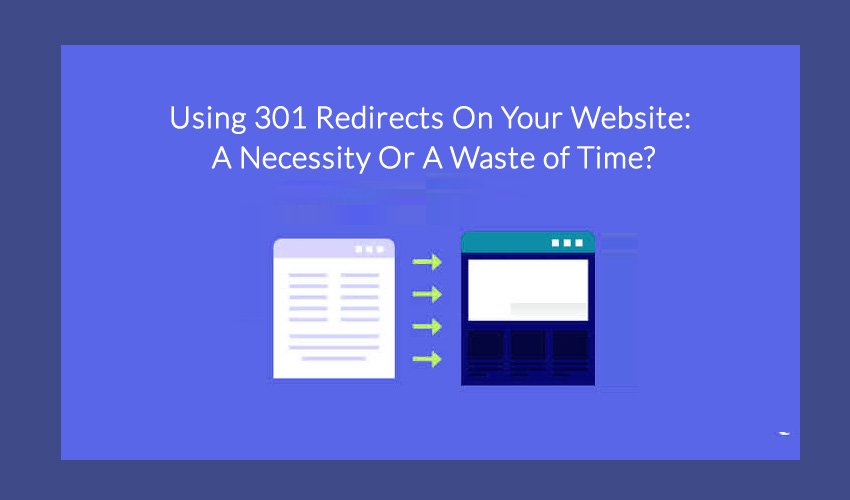Using 301 Redirects On Your Website: A Necessity Or A Waste of Time?

If you’re reading this then you probably had enough of searching if it’s a good idea to set up redirecting for your site, or rather not (in which case I totally understand you).
It’s a slightly heated debate on the Internet with people claiming why redirecting is a good solution to a “complex” problem and on the other side how harmful and unpractical it is for your WordPress site.
Even though everybody is up for 301 redirecting your URLs, there still are a couple of setbacks that might detour people from using it in the first place.
So, I believe it would be more than appropriate for you to find out if redirecting your URLs is something that you really want to do on your site or not.
This could potentially save you the headache in the future especially if you had opted for something that you don’t know that much about.
DISCLAIMER!
As I have already stated, the Internet is split on if redirecting your site is a good or bad idea and what to use in such instances. It all depends on what your problem is, what kind of site you are running and all around if it’s a good solution for you.
The needs of every site developer vary, and some might find it helpful or repulsive and unpractical in the long run.
For example, someone who has a large site that needs a lot of redirecting done in as fast of a time frame as possible will want to use 301 redirect, while on the other hand someone who has a small site and wants the redirects to go as fast and smoothest as possible will rather opt for another alternative.
Now that we cleared that out, let’s dive in deeper into the matters!
What is a 301 redirect?
So, first of all, some of you may be wondering about what exactly is a 301 redirect. Well, to put it in simple terms, it is basically a plugin that allows you to redirect users from one URL to another.
If that’s not simple enough for you, then I will make it even simpler: Redirects tell Google where the page has been moved to. By this I mean that if a user has a certain page bookmarked and somewhere down the line, the owner of the site changes the URL for that page (for reasons like wanting to migrate the site to WordPress or just wanting to change up the URL structure of the site like changing the domain).
And when the visitor clicks on his bookmark he/she will be then hit by a blank page saying “Oops 404 page not found” or something in those lines.
So, to deal with this problem you simply make the old URL guide (redirect) you to the new URL. By doing this you can save how Google perceives that URL (the ranking of the SEO) and the site in general.
By ranking I mean the SEO and site authority that influences how likely your site will pop up closer to the top of the search queue. If redirected correctly, you will get to keep your SEO and site authority even if it has changed domains meaning that Google recognizes the new site and connects it with the old one.
How to use 301 redirects?
It’s not that complicated to set up and you do not require a high technical know-how to accomplish the desired effect. Just install the plugin of your choice on your WordPress site and after you’ve done with that, go to your WordPress site and under tools click “Redirection”.
Under the space that says source URL you put the original URL that you want redirected and then finally under Target URL you put where you want it to lead to. And that’s about it! Easy as pie, right?
Using 301 redirects on your website: A necessity or a waste of time?
So, I said that redirects work if you do them correctly! Summarized, one of the downsides of redirecting is that you have the risk of screwing up completely and in turn hurt your SEO and site authority and ranking in the long run. What does this mean?
Well, if you are inexperienced with such affairs like redirecting you have to watch out that you don’t redirect your site to something completely irrelevant.
Let’s say that you want to redirect a post, blog, or generally a site that is about top foods in Thailand, and you decide to redirect users to a site, or blog that is about top drinks in Ireland.
Well, it’s universally acknowledged that Google is not stupid or easily fooled. It will know that you have redirected your URL to something completely irrelevant and it will in turn deem that URL a soft 404 which means that it will not reap the benefits of the original SEO authority.
It also means that Google could lower your site authority because you are redirecting and connecting irrelevant and contradictory posts to one another.
The speed at which redirects happen
Another con that some would argue (depending on the scale and contents of your site) is the speed at which redirects happen. If you use 301 redirects, then you might have noticed that the speed sometimes varies from site to site when redirecting is taking place.
The main issue with it is that it has to go through multiple layers in order to make the redirect happen without any hick ups. It’s easy to use and gets the job done but this is its only downside.
Some would argue that you should just rather use the WP Engine tool. It is in fact much faster because it goes only through one single layer (Server). It is a good alternative if you don’t have a whole bunch of URLs that need to be redirected.
Now, the only downside to WP Engine is that it is limited to only 1000 redirects. More than that will make too much of a strain on the server, and that’s the main reason why it’s limited to only a thousand redirects.
So, what I would recommend is that you consider using both of them to maximize your redirecting potential and overhaul speed of your site to be more or less intact.
All of that said, you also must know that if you have a whole lot of URLs that need to be redirected, the plugin you choose could do it in bulk (do multiple redirects a time) which will save you tons of time given that you don’t have to go from URL to URL and copy paste all of them.
It can do it automatically but some issues may arise and you will still have to go and fix them manually. Not that big of a con but still something to consider.
Final Thoughts
So, what can we gather from all of this? By no means is redirecting a waste of time. The only potential problem is if you don’t know what you’re doing and if you’re not careful in what you are redirecting where because in the long run this will affect your site on how well of a job you do.
Moreover, I would like to add that the only downside of redirecting is if you redirect too many URLs which will influence the site to start slowing down. So, you should definitely be picky with what you redirect and also try to avoid unnecessary redirecting and multiple layer redirecting.
You should be picky because you want a good user experience on your site that is fast and responsive and not one where they are re-counting sheep waiting for your site to redirect them to the intended URL.

